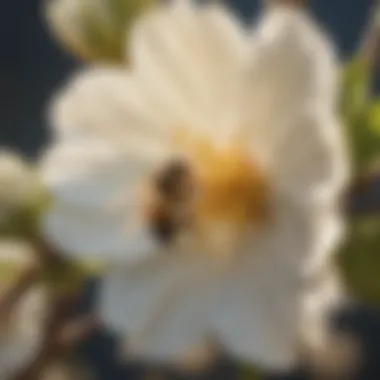Almond Trees and Bees: A Vital Pollination Partnership


Intro
The intricate relationship between almond trees and bees is a cornerstone of agricultural success in the nut industry. Almond trees, specifically, rely heavily on bees for pollination, which is essential for fruit production. As agriculturalists and stakeholders observe changes in farming practices and environmental factors, understanding this interdependence becomes increasingly crucial.
Overview of the Topic
Definition and Importance
Almond trees are flowering plants in the genus Prunus, bearing nuts that have extensive health benefits and culinary applications. The role of bees, particularly the honeybee, in pollinating almond blossoms plays a pivotal role in ensuring the effective production of quality nuts. Pollination happens when bees transfer pollen from the male part of the flower to the female part, leading to fruit development. About 80% of almond production in California, which is a key supplier, depends on bee pollination.
The importance of this relationship cannot be overstated. Without bees, the yield of almond trees would decline drastically, affecting supply chains and economies reliant on almond production.
Current Trends
Recent trends highlight the necessity of sustainable practices concerning almond orchards. Research into bee health is advancing, seeking better management techniques in beekeeping. There is also a growing awareness surrounding the impact of pesticides on bee populations and a shift towards using more eco-friendly solutions in farming. Collaboration between beekeepers and almond growers is becoming a strategy to ensure pollination reliability and improve overall habitat for bees.
Key Techniques and Practices
Step-by-Step Guide
To create a healthy and productive relationship between almond trees and bees, certain practices should be observed:
- Planting biodiversity: Encouraging various plant species near almond orchards can attract a wide range of pollinators.
- Timing of pollination: Understanding the bloom period of almond trees and synchronizing it with bee activity improves pollination success.
- Bee management: Ensuring that bee colonies are healthy, strong, and properly transported to orchards is vital.
- Pesticide management: Implementing integrated pest management (IPM) keeps pesticide use at bay during flowering periods to protect bee populations.
Tools and Equipment Needed
Successful almond cultivation involves specific tools, such as:
- Beekeeping hives
- Monitoring equipment for bee health
- Sprayers for applying eco-friendly pesticides
- Soil moisture sensors to ensure proper irrigation for almond trees
Challenges and Solutions
Common Obstacles
Several challenges confront both almond trees and bee populations:
- Declining bee populations: Factors like habitat loss and pesticide exposure lead to a decrease in bee numbers, affecting pollination.
- Climate change impacts: Changes in temperature and weather patterns may disrupt flowering schedules and bee activity levels.
- Soil health: Poor soil health can affect tree growth, reducing the overall quality of the almond harvest.
Innovative Solutions
Innovative solutions are emerging to address these challenges:
"Promoting sustainable agriculture for mutual benefit of bees and almond producers is essential."
- Habitat restoration: Planting wildflowers and creating bee-friendly areas fosters better living conditions for pollinators.
- Research initiatives: Ongoing studies into bee health support improved practices for both beekeepers and farmers.
- Holistic farming practices: Integrating various agricultural methods can enhance the health of both almond trees and bee populations, supporting a more sustainable future.
In summary, the interdependence of almond trees and bees exemplifies the intricate balance within agricultural ecosystems. Understanding this relationship helps to ensure future production and sustainability.
Prelude to Almond Trees and Bees
The relationship between almond trees and bees is not merely a footnote in agricultural history; it stands as a cornerstone of modern farming practices. Almond trees require pollination for successful fruit development, and bees play a crucial role in this process. Understanding this interdependence is vital for farmers, agricultural professionals, and environmental advocates alike.
The cultivation of almonds has expanded rapidly across various regions, particularly in California, which is the world’s largest producer. As the demand for almonds increases, so does the necessity to prioritize effective pollination strategies. The role of bees, especially honeybees, cannot be overstated, as they not only enhance almond yield but also contribute to biodiversity within the ecosystem.
Overview of Almond Cultivation
Almond cultivation involves intricate processes that require attention not just to the trees but also to the environment in which they grow. Almond trees thrive in well-drained, sandy loam soils with plenty of sunlight—conditions that are favorable in regions like California and Spain. The trees generally require a Mediterranean climate with mild, wet winters and hot, dry summers. Farmers focus heavily on irrigation and nutrient management to optimize growth and production.
Almond trees typically do not self-pollinate. This necessitates planting different cultivars to facilitate cross-pollination, which greatly enhances the almond yield. In specific terms, farmers often plant one pollenizer tree for every two to three primary production trees to ensure adequate transfer of pollen between varieties. Furthermore, the timing of blooming is crucial. Farmers must predict these blooming cycles to align them with the bee activity closely, thus enhancing pollination effectiveness.


Role of Bees in Agriculture
Bees serve as crucial pollinators for many crops, but their role in almond production is particularly notable. Pollination by bees can increase almond yields by over 50%. The primary species involved are honeybees, which are efficient at transferring pollen due to their foraging behavior. When bees visit flowers, they inadvertently collect pollen and transfer it as they move from bloom to bloom, hence initiating the pollination process.
Agricultural reliance on bees extends beyond almonds. Many major crops benefit from bee pollination, including fruits, vegetables, and nuts. This interconnectivity stresses the importance of maintaining bee health and populations. The decline in bee populations globally poses risks not only to almond production but to food security overall.
Botanical Characteristics of Almond Trees
Understanding the botanical characteristics of almond trees is crucial for optimizing both their cultivation and the role of bees in this process. Almond trees (Prunus dulcis) exhibit specific needs linked to their species, growth conditions, and susceptibility to pests and diseases. These factors not only affect the growth and yield of the trees but also directly impact the health and efficiency of the bee populations that pollinate them.
Species and Varieties
Almond trees can be broadly categorized into two main types: sweet and bitter. The sweet varieties are the focus of commercial agriculture, prized for their edible nuts. Varietal differences impact flavor, nut size, and shell characteristics. Some common varieties include Nonpareil, Carmel, and Tuono. Different varieties have distinct flowering times, which influences pollination. For instance, Nonpareil blooms early, attracting bees when they are active. Understanding these nuances helps farmers select the most appropriate varieties for their specific conditions and respective pollination strategies.
Growth Requirements
Almond trees require specific environmental conditions to thrive. They prefer well-drained soils with good aeration, as waterlogged roots can lead to decay. The trees thrive in temperate climates, needing a chilling period during winter. Typically, almonds require about 300-600 hours of chill under 7 degrees Celsius. Ensuring these trees receive sufficient sunlight is also vital; they need full sun for at least six hours per day. When farmers understand these requirements, they can create a more conducive environment for both the trees and the bees that rely on them. Proper management of the microclimate surrounding almond orchards can improve pollination success significantly.
Pest and Disease Management
Pest and disease challenges are serious considerations for almond cultivation. Common pests include the navel orange worm and aphids, which can damage the nuts and reduce yield. Diseases such as brown rot and bacterial blast can have devastating effects. Integrated Pest Management (IPM) practices are vital. This approach combines biological controls, cultural practices, and judicious use of pesticides to minimize harm. However, pesticide application needs careful monitoring, especially concerning bee populations. Research shows that neonicotinoids and other chemicals can severely affect bee health. Farmers should prioritize environmentally friendly pest management techniques to maintain a healthy balance between crop protection and pollinator well-being.
"Sustainable pest management practices play a vital role in preserving both almond yields and bee health."
Understanding Bee Biology
Understanding bee biology is essential in appreciating the symbiotic relationship between almond trees and bees. Pollination is a fundamental process that greatly influences the agricultural yield of almond trees. The role bees play in this process cannot be overstated. Their biology, behavior, and the specific types of bees that aid in almond pollination are crucial for maximizing almond production and ensuring the sustainability of this important agricultural practice.
Types of Bees Involved in Pollination
Several types of bees contribute to the pollination of almond trees. The most significant amongst them are honeybees and native bee species.
- Honeybees (Apis mellifera): This is the most common bee, used in commercial almond orchards. Their ability to produce large populations makes them ideal for orchards. They are efficient pollinators, capable of visiting many flowers in a short time.
- Bumblebees (Bombus spp.): While not as populous as honeybees, bumblebees are excellent for pollination. Their larger size allows them to vibrate flowers, facilitating pollination effectively.
- Solitary Bees: These include mason bees and orchard bees, which are important in orchard pollination. They often have specific preferences for certain plants and their pollination activities coincide with almond blooming periods.
Each bee type has distinct advantages, and their collective presence contributes to improved almond yields. Understanding the dynamics of these species helps in creating better strategies for beekeeping and crop management.
Bee Behavior and Pollination Mechanics
Bee behavior is complex and plays a significant role in pollination mechanics. Honeybees and other pollinators exhibit behaviors that increase their efficiency in flower visits.
- Foraging Behavior: Bees forage based on floral signals such as color and scent. They learn where to find food based on previous experiences, which helps them efficiently navigate through almond orchards.
- Flower Handling: Different bee species have unique methods for interacting with flowers. For instance, honeybees collect nectar while transferring pollen between blossoms. Their moving from flower to flower aids cross-pollination, which is vital for fruit development.
- Pollination Efficiency: The collective behavior of bee colonies can lead to synchronized movements, maximizing coverage of blooming almond trees. Their foraging patterns often align with the peak blooming periods of almond trees.
Understanding these behaviors and mechanisms is critical for improving pollination management strategies within almond orchards, thereby enhancing both yield and sustainability.
"Without bees, most almonds would not exist. Their pollination is a critical aspect of the crop's reproductive process."
By deepening knowledge about bee biology, almond growers can better manage their hives and incorporate efficient farming practices that support both bee health and agricultural productivity.
The Pollination Process in Almond Trees
The pollination process is vital in the life cycle of almond trees. Pollination determines the ability of almond trees to produce nuts. In fact, almost all almond varieties need cross-pollination to bear fruit. This means they rely heavily on bees to facilitate this process. Understanding the nuances of pollination can help in optimizing almond yield which is essential for farmers.
Timing and Conditions for Pollination
Pollination in almond trees occurs in the spring. The timing is crucial as the flowering period often coincides with specific climatic conditions. Ideal temperatures range from 60°F to 75°F. If the weather is too cold or too windy, bee activity decreases. This can lead to lower pollination rates. Farmers must monitor bloom times carefully.
Factors affecting the timing includes:
- Blooming period: Almond trees typically bloom from late February to early April. Different varieties bloom at different times.
- Weather conditions: Warm temperatures promote bee activity. Rain or wind can inhibit it.
- Bee availability: Beekeepers often place hives in orchards during the bloom period to maximize pollination efficiency.
For effective pollination, it is recommended to have at least two strong hives per acre. This ensures that there are enough bees to visit the flowers during peak bloom.


Impact of Pollination on Yield
The impact of pollination on almond yield cannot be overstated. Increased pollination rates lead to a higher nut set. Conversely, inadequate pollination results in a significantly reduced yield. This relationship highlights the importance of bees not just for pollination but also for economic viability in almond farming.
Key factors influenced by pollination include:
- Quality of Nuts: Good pollination improves nut quality, size, and flavor.
- Set Percentage: A higher pollination rate means more flowers will develop into fruits.
- Economic returns: Healthy yields translate into better financial returns for farmers.
Understanding these dynamics encourages farmers to implement sustainable practices. These can include:
- Utilizing native pollinators by planting wildflowers.
- Reducing pesticide applications during bloom.
Pollination is not merely a biological event; it defines the economic landscape for almond growers.
Integrating Bees into Almond Farming Practices
Integrating bees into almond farming practices is crucial for optimizing both agricultural productivity and ecological health. This relationship is not merely beneficial; it is essential for successful almond cultivation. Pollination by bees directly affects the yield and quality of almond crops. Without proper integration of bee populations, almond farmers risk lower production levels and diminished fruit quality. Understanding how to harness this relationship effectively can lead to significant economic benefits for farmers.
Best Practices for Beekeeping in Orchards
To ensure effective beekeeping within almond orchards, farmers should adhere to several best practices:
- Placement of Hives: Hives should be strategically placed near the almond trees to maximize accessibility for bees. Ideally, hives should be set up one to two weeks before the blooming period starts.
- Hive Management: Regular checks on the health of bee colonies are essential. Pest control within the hives should be managed carefully, using methods that do not harm the bees. This includes monitoring for Varroa mites and applying treatments only when necessary.
- Providing Water Sources: Bees require water for their colonies. Providing clean water sources near the orchards can foster bee activity and ensure healthy hives.
- Educating Workers: Training farm workers on how to interact with beekeepers and manage hives can lead to more efficient collaboration. Knowledge about bee behavior can prevent accidental disruption of colonies during the work process.
Following these best practices can enhance the health of bee populations, which corresponds directly to better almond yields.
Coexistence Strategies for Bees and Farmers
To foster a harmonious relationship between bees and almond farmers, specific coexistence strategies can be implemented:
- Mutual Agreements: Farmers should establish clear agreements with local beekeepers. This can include the division of responsibilities concerning hive maintenance and management.
- Natural Habitat Preservation: Maintaining areas of wildflowers and other pollinator-friendly plants within or near orchards can support bee populations. This provides bees with diverse food sources beyond just the almond blossoms.
- Minimizing pesticide use: Farmers must consider the negative impact of pesticides on bee populations. Implementing integrated pest management strategies can reduce chemical exposure for bees.
- Encouraging Research Collaborations: Farmers can partner with researchers to study the best practices on bee integration. Sharing data on pollination success can lead to improved methods and better strategies for all involved.
"The health of almond production is intricately linked to bee populations, making their integration into farming practices paramount for sustainability."
Challenges to Bee Populations
The relationship between almond trees and bees is tenuous, influenced by numerous challenges that impact bee populations. This section delves into the varied threats bees face, which ultimately affect their critical role in pollination for almond trees. Understanding these challenges is essential for agriculture farmers and enthusiasts who wish to maintain healthy bee populations and, consequently, productive almond orchards.
Pesticide Use and Its Impact
Pesticides have long been a contentious aspect of modern agriculture, with significant repercussions for bee health. The use of chemicals like neonicotinoids raises concerns among beekeepers and farmers alike. These substances can be lethal to bees and disrupt their navigation, foraging behaviors, and reproduction.
- Short-term Exposure: Bees that come into contact with pesticides may experience immediate effects, including disorientation and death.
- Chronic Exposure: Long-term exposure can lead to weakened colonies and increased vulnerability to diseases.
- Sub-lethal Effects: Even at low levels, pesticides can impair bees' abilities to communicate and locate food sources.
This impact on bee populations means less effective pollination, directly affecting almond yields. Therefore, it is crucial for farmers to consider adopting Integrated Pest Management (IPM) approaches that minimize harmful pesticide use while maximizing crop health.
Habitat Loss and Environmental Change
Habitat loss and environmental change present severe threats to pollinator populations. Urbanization, agricultural expansion, and climate change have altered landscapes, diminishing the available habitats for bees.
- Reduction of forage resources: Bee species require diverse forage to thrive. Loss of wildflowers and native plants reduces the pollinators’ food supply and nesting sites.
- Climate Change Effects: Shifting climates influence flowering times of plants, sometimes causing mismatch between the blooming of almond trees and bee activity. Some bee species may not adapt quickly to these changes, resulting in decreased populations.
- Fragmentation of Habitats: When natural habitats are fragmented, bee populations may become isolated, reducing genetic diversity and resilience.
Addressing habitat loss involves strategies that promote biodiversity and the restoration of natural spaces. Farmers can play a pivotal role by creating pollinator-friendly environments, such as planting cover crops or maintaining hedgerows within almond orchards.
"Conservation efforts are essential to ensure that both bees and almond trees can thrive in an ever-changing environment."
Mitigating the challenges facing bee populations is vital for sustaining the intricate interplay between almond trees and their pollinators. It fosters not only better crop yields but also supports ecological balance, benefiting farmers and the broader environment.
Sustainable Practices in Almond Cultivation
Sustainable practices in almond cultivation are crucial for enhancing both the health of almond trees and the well-being of bee populations. Given the interdependent relationship between these two vital components, it is important to focus on methods that sustain their coexistence. Sustainability in almond farming not only increases productivity but also mitigates negative environmental impacts. Farmers must consider various factors when adopting these practices, including soil health, water usage, and the overall ecosystem. The benefits of these practices extend beyond individual farms and positively affect wider agricultural landscapes.


Organic Almond Farming
Organic almond farming represents a growing trend aimed at eliminating synthetic pesticides and fertilizers from the cultivation process. This method prioritizes natural inputs, promoting soil health and biodiversity. The significant benefits of organic farming include:
- Enhanced Soil Quality: Organic farming improves soil structure, encourages microbial life, and maintains nutrient levels through practices like cover cropping and composting.
- Pollinator Well-being: By avoiding harmful chemicals, organic farms create a safe environment for bees. Healthier bee populations lead to improved pollination rates, ultimately contributing to higher almond yields.
- Market Demand: There is a rising consumer preference for organic products. Farmers who engage in organic farming can access higher prices and a loyal customer base.
However, organic almond farmers face challenges. Limited pest control options and potential reductions in yields during the transition from conventional farming are significant concerns. Nevertheless, with strategic planning and adaptability, these challenges can be addressed.
Pollinator-Friendly Farming Techniques
Integrating pollinator-friendly farming techniques is essential for fostering a sustainable almond cultivation ecosystem. These techniques can encompass a variety of actions aimed at protecting and encouraging bee populations. Some effective methods include:
- Creating Habitat: Farmers can plant native flowering plants around orchards to produce additional forage for bees. Diverse plantings attract various pollinator species, creating a supportive ecosystem.
- Minimizing Pesticide Usage: Implementing Integrated Pest Management (IPM) practices reduces reliance on chemical pesticides. This approach involves monitoring pest levels and applying targeted, less harmful alternatives when necessary.
- Providing Water Sources: Ensuring that water sources are accessible to bees is another essential aspect of sustainable practices. Simple installations like shallow dishes filled with water and pebbles can help bees hydrate.
In summary, sustainable practices like organic almond farming and pollinator-friendly techniques offer multi-faceted benefits that support both agricultural outcomes and environmental health. As farmers increasingly recognize the importance of bees, their role within almond cultivation becomes vital.
Future Trends in Almond Production
The landscape of almond production is evolving rapidly. As stakeholders in agriculture become more aware of the intricacies of almond trees and their pollination needs, future practices are expected to prioritize sustainability and efficiency. Increasing demand for almonds worldwide calls for innovations that address both yield and environmental impact. This section delves into the future trends that are shaping the almond industry today and beyond.
Technological Innovations in Pollination
Technological integration in agricultural practices is becoming a cornerstone of modern farming. In almond production, advanced techniques are emerging to enhance pollination, a critical factor in ensuring high yields. Innovations such as drones equipped with sensors may assist in monitoring bee activity and pollination patterns. These drones can gather real-time data on flower density and bee flight paths, offering valuable insights to farmers.
Additionally, precision agriculture tools can help optimize the timing of pollination. By tracking temperature and humidity levels, farmers can make informed decisions about when to introduce bee colonies to almond orchards. This technology aims to improve pollination efficiency, which is necessary for maximizing crop yield.
Furthermore, artificial intelligence systems could develop predictive models that assess the best planting strategies. Analyzing historical data can lead to improved variety selection and spatial organization in orchard design, ultimately benefiting both the bees and the trees.
Research and Development in Almond Cultivation
Ongoing research in almond cultivation is crucial for addressing emerging challenges. Scientists are constantly exploring strategies that enhance the health of almond trees while simultaneously promoting pollinator populations. Research on almond varieties that require less pollination or are more resilient to climate variability is gaining traction. Such developments aid in ensuring that almond production remains viable in changing environmental conditions.
Moreover, initiatives to study bee behavior in orchards can lead to better management practices. Understanding the needs of various bee species that contribute to almond pollination can improve coexistence strategies between beekeepers and farmers.
Regenerative agriculture practices are also a focal point in research. Techniques that improve soil health and biodiversity can positively affect both almond trees and the bees that pollinate them. By investing in research and development, the almond industry can secure a sustainable future, ensuring long-term productivity and ecological balance.
"Innovative agricultural technology, combined with focused research, holds the potential to reshape almond production for the better."
As we look forward to the future, it is evident that the relationship between almond trees and bees will play a fundamental role in shaping the practices of tomorrow. The focus remains on sustainability and innovation, ensuring that both almond cultivation and bee populations thrive in harmony.
Epilogue: The Vital Nexus of Almond Trees and Bees
The interdependence between almond trees and bees is not only a fascinating aspect of agricultural science, but it also represents a crucial factor in sustaining food production. This relationship underscores how vital bees are to the effective cultivation of almonds, which are a significant crop in many regions. Understanding this connection is essential for both farmers and environmental advocates as ecosystems and agricultural practices evolve.
Almond trees rely heavily on bees for pollination, which directly impacts their yield and fruit quality. A single almond tree can produce an estimated 10,000 flowers, but without sufficient bee activity, many of these blossoms will not develop into nuts. This points to the essential role of bee populations in ensuring successful almond harvests.
Moreover, bees provide benefits beyond just pollination. Their activities support biodiversity, which is critical for the health of agricultural ecosystems. Healthy bee populations promote a vibrant environment in which various plant species can thrive. The health of almond orchards is thus directly linked to sustainable beekeeping practices, creating a symbiotic relationship that benefits both crops and pollinators.
As challenges arise, such as habitat loss and the effects of pesticides, the importance of protecting both bees and almond cultivation grows. The sustainability of these practices hinges upon awareness, education, and cooperation between different stakeholders in the agricultural community.
"Sustainable practices in almond farming ensure the vitality of both trees and the vital bees that pollinate them."
Summary of Key Insights
The examination of almond trees and their relationship with bees reveals several critical points:
- Almond trees depend on bee pollination for fruit production.
- The decline in bee populations poses a direct threat to almond yields.
- Coordinated efforts between beekeepers and almond growers improve productivity and ecological balance.
- Sustainable farming practices can enhance both bee health and almond production.
By considering these insights, stakeholders can better appreciate the interconnectedness of ecosystems within agricultural frameworks.
Call to Action for Sustainable Practices
Moving forward, it is imperative for all involved in almond cultivation and beekeeping to consider adopting sustainable practices. This includes:
- Reducing pesticide use: Select alternative pest management strategies that minimize harm to bees.
- Promoting habitat conservation: Support efforts to preserve wild bee habitats around almond orchards.
- Increasing awareness and education: Share knowledge about the role of bees in agriculture with the broader community.
- Implementing pollinator-friendly farming techniques: Encourage practices that support both crops and pollinators.
Taking these steps will not only help secure the future of almond production but also enhance the health of bee populations. The mutual benefit of sustainable agriculture ensures the longevity of both species and the environment they collectively inhabit.



